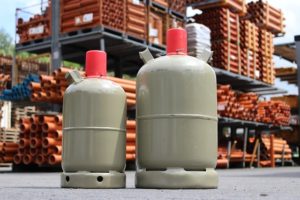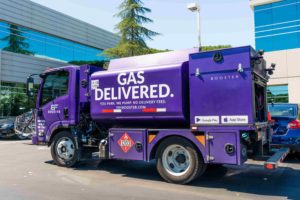
- Products
- Solutions
- Learn
- Partner
- Try Now
“On-demand gas” is rather hard to imagine a start-up for a combustible commodity like gasoline. And yet, the latest target for disruptive innovation by the tech industry is fuel stations. As proof of this, over the past 20 months, at least eight startups have launched variations on the theme of “Uber for gas”– your car’s tank gets refilled while it is parked somewhere or wherever a fill is needed.
Delivering large quantities of a flammable liquid is complicated and regulated. The companies delivering gas on-demand generally source their gasoline from the same distributors that supply to retail gas stations. The app companies put the fuel in pickup trucks or specially designed mini-tankers.

Some Popular On-Demand Gas Delivery Apps
Services that offer mobile fill-up options at the touch of an app are proliferating. Below are some of the popular on-demand gas delivery / “Uber for gas” apps that have made headlines and got coverage in the on-demand fuel delivery space with an eye on the $320 billion U.S. retail gasoline market.
- WeFuel: WeFuel is one of the new startups that currently operates in Mountain View, Palo Alto, Los Alto and Menlo Park, USA. WeFuel’s gas will cost the average price per gallon in the user’s zip code, plus a $7.49 delivery fee. The company also offers an unlimited delivery subscription model at $19.99 per month. They are also working on a device users can install in their car to allow WeFuel to monitor tank levels from afar and deliver gas when needed–even when the user is not there.
- Filld: Filld, which raised more than $3.25 million in seed funding, has been operating in Silicon Valley since last year. Filld determines its price through an average of the gas stations around you – but then adds a $5 service fee. The app is simple. You order the gas like you would order an Uber, by placing a pin at the location, and one of Filld’s trucks comes and fills your tank.
- Booster: Booster has raised a $9 million so far. Currently, Booster services are available in the San Francisco Bay area and the Dallas-Fort Worth area. They claim that gas prices can sometimes be lower than what is available at gas stations because Booster buys gasoline at wholesale prices. It doesn’t have the high real-estate costs associated with owning and operating a gas station, it makes money on the difference.
- Yashi Inc: Yashi has raised $2.1 million in a new round of venture funding to expand its gas delivery service into new towns, and to add different auto-related services to its menu. Yoshi charges drivers $20 per month for a subscription, plus the cost of regular or premium gas. The company does not send its fuel-bearing trucks and personnel to fill up a single car in a driveway. There must be at least three Yoshi-member vehicles within the same lot to initiate its service.

How does on-demand gas delivery work?
They are app-based services and work like Uber for fuel. Though the basic service is to get gas filled without having to visit a gas station, each of the companies has its own revenue model.
The working concept of fuel on-demand/ gas on-demand services is simple enough that you don’t need to head towards the fuel filling stations when the tank is about to get empty. Using this, you will be able to request fuel online in a few easy steps:
- Register: Users simply need to download the app and provide their personal details to register.
- Share Location: Users can easily share the current vehicle location on a map.
- Request Fuel: Users can choose fuel type, quantity and confirm price.
- Get Gas Delivered: Get the fuel delivered right at the customer’s doorstep.
Once you are done with the above process, within a few minutes, a fuel delivery truck will be there at the user’s location. Skipping the gas filling station as a middleman, on-demand gas delivery services bring the fuel to you, adhering to all required norms and safety regulations.
With on-demand fuel delivery, consumers can prioritize their time more efficiently and minimize the time spent waiting in long queues at the gas station. The launch and popularity of various on-demand services promise to bring transformation in the typical process of driving to the fuel station.
As on-demand technology has fully taken over the transportation market, on-demand gas delivery is waiting to be explored. Be it a long weekend drive for a holiday or daily commuting to the workplace, everyone has to visit a gas station to get a refill. Avoiding long queues at gas stations, pollution, adulteration and poor handling by operators can make the experience of getting gas filled an unpleasant one. The emergence of on-demand fuel delivery apps and services can be a boon to those expecting convenience at their fingertips.
Opt the Qcommerce model to speed up your on-demand gas and fuel delivery
Earlier we use to visit a shop for purchasing the required items. As there was no other choice but then eCommerce comes into the picture where we got the flexibility to order items from an app and get delivery after few days.
But businesses that rely on convenience products or rapid consumption require immediate home/spot delivery, which will be known as Qcommerce the future of eCommerce, where we will get delivery within an hour or less than that.
- Less than <1 hour delivery: Large marketplaces and online retailers are now able to deliver the same day or within hours, cutting delivery times by leaps and bounds.
- Localized: It is obvious that, no matter how powerful logistics are, delivery ranges must be constrained by proximity.
- Convenience: the orders received are, of course, for immediate consumption. Hunger takes a back seat to necessity.
- Decentralization: Provide quick and efficient service to meet customers’ expectations and specific requirements in each area.
- Availability: Not everyone has the luxury of having stock ready for fast delivery. As a result, many of these Q-Commerce eCommerce businesses are more like service providers than retailers. They make the buy and deliver it, with the management costing more than the product.
The above features can be easily handled via the Internet. And in order to provide a superfast local delivery, you can always switch to a hyperlocal delivery business model.
How Yelo powers businesses with fast gas and fuel delivery services
Gas and fuel are an essential part of daily life, Imagine you are cooking food on your gas stove and you ran out of gas, or you are traveling somewhere and you ran out of fuel. what will you do?
In both cases, you won’t be panic if you have the flexibility to order gas or fuel with an app and then get faster delivery.
Besides providing faster gas and fuel delivery for customers, Q-commerce has reshaped the hyperlocal gas and fuel delivery industry, creating greater opportunities for businesses to expand and grow. In order to build the right on-demand Whitelabel app and to ensure a successful, speedy delivery process you need the right ordering and delivery platform.
Here are some major features your ordering and delivery platform should include:
- Multiple micro fulfilment stores – It’s crucial for hyperlocal stores to have the capability of launching and managing multiple stores in different areas to make gas or fuel storage and delivery to customers easier and faster to compete with their national competitors. In order to accomplish this, you should be able to manage and display your menu and inventory in stores according to customer locations.
- Incorporating the right delivery platform – Any hyperlocal ordering business relies on seamless delivery integration. With Yelo, a hyperlocal ordering platform, you can accept orders on your app, and Tookan, a #1 delivery platform, seamlessly integrates with it in just one click. A seamless mapping algorithm allows you to automatically assign delivery boys or drivers as per their locations.
- Heat-maps in your delivery platform – Your drivers can use this feature to determine what local locations receive the most orders.Thus, enabling faster delivery.
- Payment Integration – Multiple payment gateways with smooth integration are another important feature to ensure quickest delivery. You should have an open line of payment gateways for your customers. the opportunity to pay online using the payment gateway that best suits their availability, ensuring hasslefree payments and customer satisfaction.
Despite the pandemic’s damage, many gases and fuel companies have expanded their offers by focusing on distribution and leveraging technology to reestablish themselves and demonstrate their agility. Companies, particularly small and medium-sized businesses, and startups have an immediate potential to leverage the pandemic’s aftereffects into innovation and growth.
JungleWorks has developed tons of on-demand solutions for many industries, including the oil and gas industry. Our developers are well-versed in developing on-demand apps for fuel delivery and are responsible for the uberfication of many in the service industry. If you are a startup that needs assistance to build your own app, just send us a quick inquiry, and our On-demand app development experts will be more than happy to help you.
Subscribe to stay ahead with the latest updates and entrepreneurial insights!

Subscribe to our newsletter
Get access to the latest industry & product insights.





















